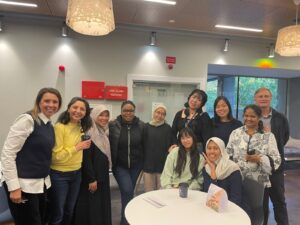My First Experience Leading a Festival of Social Science 2023 Event
In this blog, Dr Catherine Clarissa shares her experiences leading and organising our YARNS Transitions public engagement events, which were a part of the Festival of Social Science 2023. Clarissa leads Work Package 1 of the YARNS Transitions project, involving a realist review of psychosocial interventions for young adults undergoing neurorehabilitation after an acquired brain injury (ABI).
About the Festival of Social Science
We are truly delighted that this year we were able to participate in the annual Economic and Social Research Council (ESRC) Festival of Social Science. For those unfamiliar with the festival, it is an annual celebration of the social sciences and part of the ESRC’s commitment to promoting awareness of UK social science research to new audiences. Each year, there is a theme, and this year’s theme was Lifelong Wellbeing.
The idea
Our main aim was to disseminate the YARNS Transitions project and increase awareness of brain health and acquired brain injury (ABI). It was rewarding to see our ideas align with the Festival of Social Science 2023 theme, securing us the grant. We planned two events—one at the main concourse of Edinburgh Waverley Station and another at the Royal Commonwealth Pool in Edinburgh.
The inspirations behind our activities
When I was brainstorming the event, I wanted activities that everyone would enjoy—fun yet educational. We ended up with four: a 360-video, maze and puzzle challenges, colouring, and a brain model. Let me break them down for you.
The idea for the 360-video activity came to me after reflecting on the Interprofessional Education (IPE) session for medical and nursing students. The students used virtual reality (VR) headsets to watch a 360 video that put them in the viewpoint of a patient receiving personal care. I thought we could create a similar video to highlight the experiences of young adults who are often stigmatised due to their slurred speech, often mistaken for drunkenness (this is backed by research evidence). This activity would hopefully provide an opportunity for the public to experience what it’s like to be in the shoes of these young adults. We can also use the same video to teach our students after the event.
Recording a 360 Video
I never expected that one day I’d be directing and creating a scenario in my academic career, let alone learning to operate a 360 GoPro camera! When drafting the scenario, I tried to put myself in the shoes of a young adult dealing with ABI. The valuable input from the experts by experience on our Advisory Board reassured me that the scenario was sensible. Yet, the real stars of the video were my talented colleagues and students whose acting skills brought the vision to life! A huge thanks goes out to Colin Chandler for his video editing skills.

Our YARNS Transition cast members
The maze and puzzle challenges came from my experience teaching students about empathy while working with stroke patients. We once had a mirror maze activity that was highly enjoyed by the students. The purpose of this game was to simulate apraxia, a common issue for stroke patients where the brain knows the move but can’t quite coordinate it. Since our students enjoyed it so much, it would be a great fit for the public too.
While focusing on engaging adults, I didn’t want to forget about the kids. That’s when the idea came for the third activity — colouring various brain parts. We provided several colouring sheets illustrating the human brain and its various areas that control different functions. This way, we could create a fun yet educational activity. Also, I searched on the Internet and I found a brain hat template that looks really fun! So we brought along this template for those who want to create one at home.
For our final activity, we wanted to bring in a brain model so people could get a hands-on opportunity to explore it. They could get a closer look at the human brain and learn its anatomy.
Planning
Preparation wasn’t just about planning activities, but it also involved reaching out to potential venues and sorting through the necessary paperwork. The paperwork primarily concerned safety, showing that a top priority for organising events in a public setting. A big lesson I learned: always ask when you’re unsure. I reached out to some experienced researchers, and they were very kind in sharing their experiences and tips from their own events.
Summary
This experience has given me a lot of learning opportunities. I got to refine my organisation skills, foster creative thinking in activity planning, and gain insights into the paperwork and safety requisites necessary for conducting events in public spaces. I picked up some recording skills along the way too! Overall, leading this event and spreading the word about YARNS Transitions and raising awareness of brain health and ABI was a truly fulfilling experience.
Acknowledgement
We express our gratitude for the opportunity provided by the Festival of Social Science and the Economic and Social Research Council. Our appreciation also goes to our volunteers — for their efforts in preparing and running the events; SameYou and the RCN Foundation—for promoting our events, alongside the World Stroke Organization. Special thanks to Shonagh McEwan and Mara Götz from the Research Engagement & Impact Team for their patient guidance and consistent support. Without this immense support, these events would not have been possible.
Calling for young adult ABI survivors!
If you live in the UK and would like to help guide our research project, please contact us at our email address, yarnspro@ed.ac.uk or social media, X @YANRSproject . We would love to know any insights you may have to improve our work.
We are looking forward to hearing from you!




Recent comments